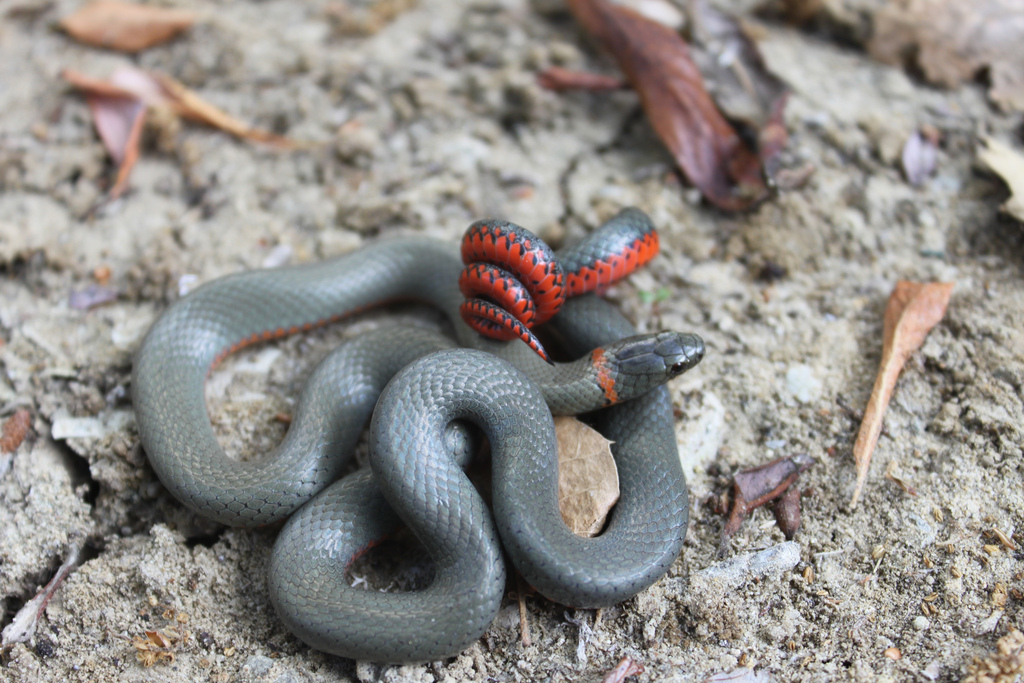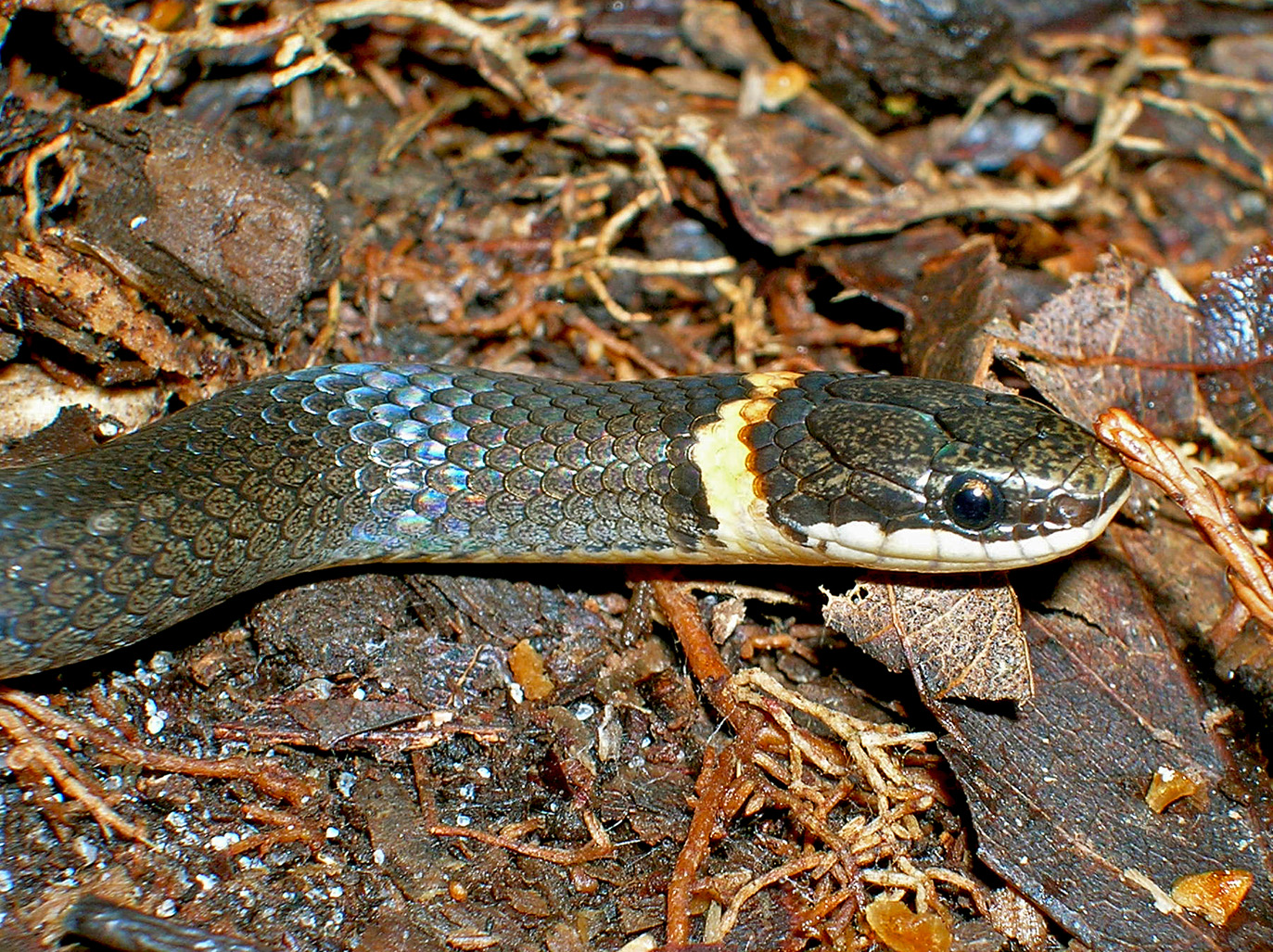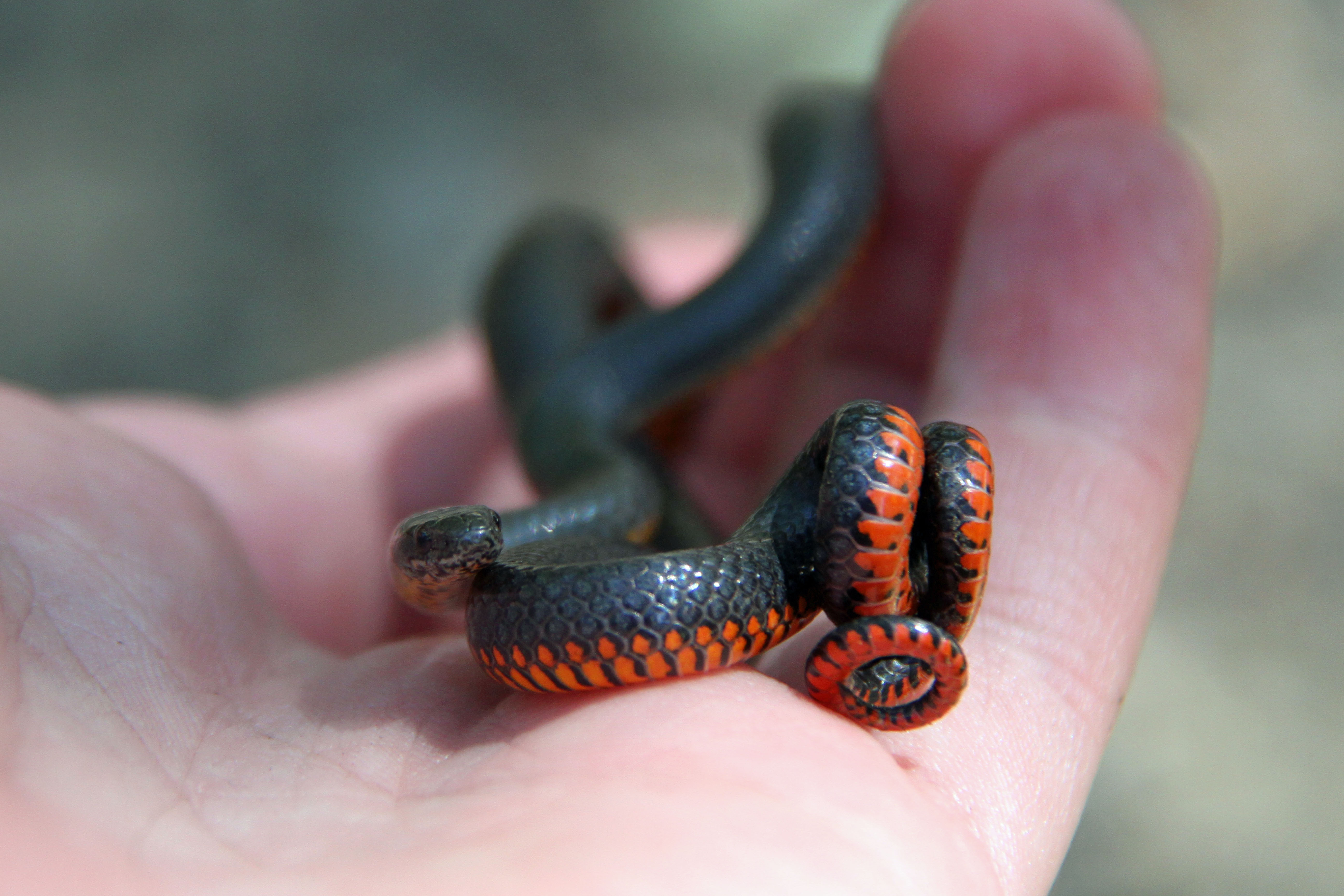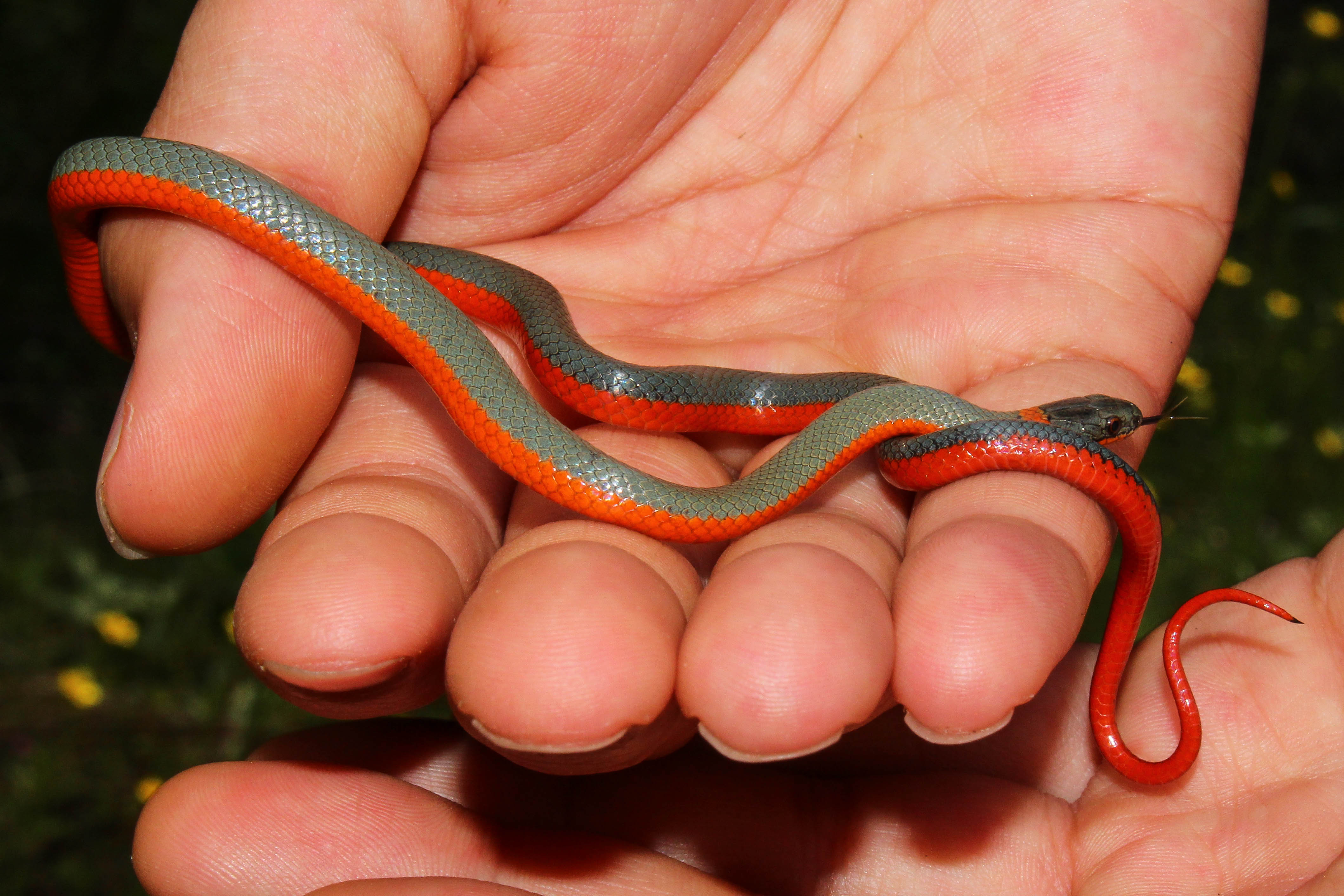Ringneck snake on:
[Wikipedia]
[Google]
[Amazon]
 ''Diadophis punctatus'', commonly known as the ring-necked snake or ringneck snake, is a harmless
''Diadophis punctatus'', commonly known as the ring-necked snake or ringneck snake, is a harmless

 Ring-necked snakes are fairly similar in morphology throughout much of their distribution.
Ring-necked snakes are fairly similar in morphology throughout much of their distribution.
 Its Dorsum (biology), dorsal coloration is solid olive, brown, bluish-gray to smoky black, broken only by a distinct yellow, red, or yellow-orange neck band.:fr:Robert Cyril Stebbins, Stebbins RC (2003). ''A Field Guide to Western Reptiles and Amphibians, Third Edition''. The Peterson Field Guide Series ®. Boston and New York: Houghton Mifflin Company. . (''Diadophis punctatus'', pp. 345–346 + Plate 46 + Map 133). A few populations in New Mexico, Utah, and other distinct locations do not have the distinctive neck band. Additionally, individuals may have reduced or partially colored neck bands that are hard to distinguish; coloration may also be more of a cream color rather than bright orange or red. Head coloration tends to be slightly darker than the rest of the body, with tendencies to be blacker than grey or olive. Ventrally, the snakes exhibit a yellow-orange to red coloration broken by crescent-shaped black spots along the margins. Some individuals lack the distinct ventral coloration, but typically retain the black spotting. Rarely, do individuals lack both the ventral and neck band coloration; so the use of those two characteristics is the simplest way to distinguish the species.
Size also varies across the species' distribution. Typically, adults measure in length, except for ''D. p. regalis'', which measures . First-year juvenile snakes are typically about and grow about a year depending on the developmental stage or resource availability.
Ring-necked snakes have smooth scales with 15–17 scale rows at midbody. Males typically have small tubercles on their scales just anterior to the vent, which are usually absent in females.
Its Dorsum (biology), dorsal coloration is solid olive, brown, bluish-gray to smoky black, broken only by a distinct yellow, red, or yellow-orange neck band.:fr:Robert Cyril Stebbins, Stebbins RC (2003). ''A Field Guide to Western Reptiles and Amphibians, Third Edition''. The Peterson Field Guide Series ®. Boston and New York: Houghton Mifflin Company. . (''Diadophis punctatus'', pp. 345–346 + Plate 46 + Map 133). A few populations in New Mexico, Utah, and other distinct locations do not have the distinctive neck band. Additionally, individuals may have reduced or partially colored neck bands that are hard to distinguish; coloration may also be more of a cream color rather than bright orange or red. Head coloration tends to be slightly darker than the rest of the body, with tendencies to be blacker than grey or olive. Ventrally, the snakes exhibit a yellow-orange to red coloration broken by crescent-shaped black spots along the margins. Some individuals lack the distinct ventral coloration, but typically retain the black spotting. Rarely, do individuals lack both the ventral and neck band coloration; so the use of those two characteristics is the simplest way to distinguish the species.
Size also varies across the species' distribution. Typically, adults measure in length, except for ''D. p. regalis'', which measures . First-year juvenile snakes are typically about and grow about a year depending on the developmental stage or resource availability.
Ring-necked snakes have smooth scales with 15–17 scale rows at midbody. Males typically have small tubercles on their scales just anterior to the vent, which are usually absent in females.


Ringneck snake – ''Diadophis punctatus''
Species account from the Iowa Reptile and Amphibian Field Guide.
"Black Snakes": Identification and Ecology
– University of Florida fact sheet. {{Taxonbar, from=Q2704229 Colubrids Snakes of North America Reptiles of Canada Reptiles of Mexico Reptiles of the United States Fauna of the Eastern United States, Snake, Ringneck Reptiles described in 1766 Taxa named by Carl Linnaeus
 ''Diadophis punctatus'', commonly known as the ring-necked snake or ringneck snake, is a harmless
''Diadophis punctatus'', commonly known as the ring-necked snake or ringneck snake, is a harmless species
In biology, a species is the basic unit of classification and a taxonomic rank of an organism, as well as a unit of biodiversity. A species is often defined as the largest group of organisms in which any two individuals of the appropriate s ...
of colubrid
Colubridae (, commonly known as colubrids , from la, coluber, 'snake') is a family of snakes. With 249 genera, it is the largest snake family. The earliest species of the family date back to the Oligocene epoch. Colubrid snakes are found on ev ...
snake found throughout much of the United States, central Mexico, and south-eastern Canada. Ring-necked snakes are secretive, nocturnal snakes, so are rarely seen during the day time. They are best known for their unique defense posture of curling up their tails, exposing their bright red-orange posterior, ventral surface when threatened.
Ring-necked snakes are believed to be fairly abundant throughout most of their range, though no scientific evaluation supports this hypothesis. Scientific research is lacking for the ring-necked snake, and more in-depth investigations are greatly needed. It is the monotypic, only species within the genus ''Diadophis'', and currently 14 subspecies are identified, but many herpetologists question the morphologically based classifications.
Description

 Ring-necked snakes are fairly similar in morphology throughout much of their distribution.
Ring-necked snakes are fairly similar in morphology throughout much of their distribution.
 Its Dorsum (biology), dorsal coloration is solid olive, brown, bluish-gray to smoky black, broken only by a distinct yellow, red, or yellow-orange neck band.:fr:Robert Cyril Stebbins, Stebbins RC (2003). ''A Field Guide to Western Reptiles and Amphibians, Third Edition''. The Peterson Field Guide Series ®. Boston and New York: Houghton Mifflin Company. . (''Diadophis punctatus'', pp. 345–346 + Plate 46 + Map 133). A few populations in New Mexico, Utah, and other distinct locations do not have the distinctive neck band. Additionally, individuals may have reduced or partially colored neck bands that are hard to distinguish; coloration may also be more of a cream color rather than bright orange or red. Head coloration tends to be slightly darker than the rest of the body, with tendencies to be blacker than grey or olive. Ventrally, the snakes exhibit a yellow-orange to red coloration broken by crescent-shaped black spots along the margins. Some individuals lack the distinct ventral coloration, but typically retain the black spotting. Rarely, do individuals lack both the ventral and neck band coloration; so the use of those two characteristics is the simplest way to distinguish the species.
Size also varies across the species' distribution. Typically, adults measure in length, except for ''D. p. regalis'', which measures . First-year juvenile snakes are typically about and grow about a year depending on the developmental stage or resource availability.
Ring-necked snakes have smooth scales with 15–17 scale rows at midbody. Males typically have small tubercles on their scales just anterior to the vent, which are usually absent in females.
Its Dorsum (biology), dorsal coloration is solid olive, brown, bluish-gray to smoky black, broken only by a distinct yellow, red, or yellow-orange neck band.:fr:Robert Cyril Stebbins, Stebbins RC (2003). ''A Field Guide to Western Reptiles and Amphibians, Third Edition''. The Peterson Field Guide Series ®. Boston and New York: Houghton Mifflin Company. . (''Diadophis punctatus'', pp. 345–346 + Plate 46 + Map 133). A few populations in New Mexico, Utah, and other distinct locations do not have the distinctive neck band. Additionally, individuals may have reduced or partially colored neck bands that are hard to distinguish; coloration may also be more of a cream color rather than bright orange or red. Head coloration tends to be slightly darker than the rest of the body, with tendencies to be blacker than grey or olive. Ventrally, the snakes exhibit a yellow-orange to red coloration broken by crescent-shaped black spots along the margins. Some individuals lack the distinct ventral coloration, but typically retain the black spotting. Rarely, do individuals lack both the ventral and neck band coloration; so the use of those two characteristics is the simplest way to distinguish the species.
Size also varies across the species' distribution. Typically, adults measure in length, except for ''D. p. regalis'', which measures . First-year juvenile snakes are typically about and grow about a year depending on the developmental stage or resource availability.
Ring-necked snakes have smooth scales with 15–17 scale rows at midbody. Males typically have small tubercles on their scales just anterior to the vent, which are usually absent in females.
Distribution
Ring-necked snakes are fairly common throughout much of the United States extending into southeastern Canada and central Mexico. Eastern populations cover the entire Eastern Seaboard from the Gulf of Saint Lawrence continuous through the Gulf Coast of Texas. Distribution moves inland into northern Minnesota, continuing diagonally through the US to include all of Iowa, eastern Nebraska, and most of Kansas. In the western US, the distribution is significantly less continuous, with spotty, distinct population segments through most of the Pacific Northwest. Populations extend from south-central Washington continuing along the extreme West Coast into Mexico. Population segments extend inland into western Idaho, through southern Nevada, into central Utah, and continuing south through Arizona and central Mexico.Habitat
Ring-necked snakes occur in a wide variety of habitats. Preference seems to be determined by areas with abundant cover and denning locations. Northern and western subspecies are found within open woodlands near rocky hillsides, or in wetter environments with abundant cover or woody debris. Southern subspecies exist primarily within riparian and wet environments, especially in more arid habitats. Stebbins (2003) identified the species as a snake of moist habitats, with moist soil conditions the preferred substrate. Ring-necked snakes are also not found above an elevation of . In northern regions, dens are also important in identifying suitable ring-necked snake habitat. Dens are usually shared communally, and are identifiable by an existent subsurface crevasse or hole deep enough to prevent freezing temperatures. Since it is a woodland reptile, it can also commonly be found under wood or scraps. Because of hot weather, they tend to make holes and burrows, or they hide under rocks or any suitable material. They are normally found in flatland forests. Though they prefer to remain away from human-made structures, ring-neck snakes are not afraid to utilize urbanized areas as refuge from predators.Diet
The diet of the ring-necked snake consists primarily of smaller salamanders, earthworms, and slugs, but they also sometimes eat lizards, frogs, and some juvenile snakes of other species. The frequency at which Predation, prey species are chosen is dependent on their availability within the habitat. Michigan populations of the Eastern Ring-necked Snake (''Diadophis punctatus edwardsii'') feed almost exclusively on Red-backed salamander, red-backed salamanders. Ring-necked snakes use a combination of constriction and envenomation to secure their prey. In a study analyzing the dietary habits of this species, age, amount of food consumed, and temperature were conditions that highly affected digestion.The snakes do not have a true venom gland, but they do have an analogous structure called the Duvernoy's gland derived from the same tissue. Most subspecies are Opisthoglyphous, rear-fanged with the last maxillary teeth on both sides of the upper jaw being longer and channeled; the notable exception is ''D. p. edwardsii'', which is fangless. The venom is produced in the Duvernoy's gland located directly behind the eye. It then drains out of an opening at the rear of the maxillary tooth. Ring-necked snakes first strike and then secure the prey using constriction. Next, they maneuver their mouths forward, ensuring the last maxillary tooth punctures the skin and allowing the venom to enter the prey's tissue. The secretion significantly affects the righting response of the prey. Ring-necked snakes are rarely aggressive to larger predators, suggesting their venom evolved as a feeding strategy rather than a defense strategy. Rather than trying to bite a predator, the snake winds up its tail into a corkscrew, exposing its brightly colored belly. Ring-necked snakes are primarily nocturnal or highly crepuscular, though some Diurnality, diurnal activity has been observed. Individuals are sometimes found during the day, especially on cloudy days, sunning themselves to gain heat. Yet, most individuals lie directly under surface objects warmed in the sun and use conduction with that object to gain heat. Though ring-necked snakes are highly secretive, they do display some social structure, but the exact social hierarchies have never been evaluated. Many populations have been identified to have large colonies of more than 100 individuals, and some reports indicate some smaller colonies occupy the same microhabitats.
Reproduction
Ring-necked snakes usually mate in the spring. In some subspecies, though, mating occurs in the fall, and delayed implantation occurs. Females attract males by secreting pheromones from their skin. Once the male finds a female, he starts by moving his closed mouth along the female's body. Then, the male bites the female around her neck ring, maneuvering to align their bodies so sperm can be inserted into the female's vent. Females lay their eggs in loose, aerated soils under a rock or in a rotted log.Zeiner DC, Laudenslayer WF, Mayer KE, White M (eds.) (1988–1990). ''California's Wildlife, Volume I, Amphibians and Reptiles''. Sacramento, California: California Department of Fish and Game. Three to ten eggs are deposited in early summer and hatch in August or September. The egg is elongated with a white color contrasted by yellow ends. When hatched, juveniles are precocial and fend for themselves without parental care.Subspecies
The following 14 subspecies are recognized. * ''Diadophis punctatus acricus, D. p. acricus'' species:Dennis R. Paulson, Paulson, 1966 — Key ring-necked snake * ''Diadophis punctatus amabilis, D. p. amabilis'' (Spencer Fullerton Baird, Baird & Charles Frédéric Girard, Girard, 1853) — Pacific ring-necked snake * ''Diadophis punctatus anthonyi, D. p. anthonyi'' (John Van Denburgh, Van Denburgh & Joseph Richard Slevin, Slevin, 1942) — Todos Santos Island ring-necked snake * ''Diadophis punctatus arnyi, D. p. arnyi'' (Robert Kennicott, Kennicott, 1859) — prairie ring-necked snake *''Diadophis punctatus dugesii, D. p. dugesii'' () — Alfredo Dugès, Dugès' ring-necked snake *''Diadophis punctatus edwardsii, D. p. edwardsii'' — northern ring-necked snake * ''Diadophis punctatus modestus, D. p. modestus'' (Marie Firmin Bocourt, Bocourt, 1866) — San Bernardino ring-necked snake * ''Diadophis punctatus occidentalis, D. p. occidentalis'' (Frank Nelson Blanchard, Blanchard, 1923) — northwestern ring-necked snake * ''Diadophis punctatus pulchellus, D. p. pulchellus'' (Baird & Girard, 1853) — coralbelly ring-necked snake * ''Diadophis punctatus punctatus, D. p. punctatus'' (Carl Linnaeus, Linnaeus, 1766) — southern ring-necked snake * ''Diadophis punctatus regalis, D. p. regalis'' (Baird & Girard, 1853) — regal ring-necked snake * ''Diadophis punctatus similis, D. p. similis'' (Blanchard, 1923) — San Diego ring-necked snake * ''Diadophis punctatus stictogenys, D. p. stictogenys'' (Edward Drinker Cope, Cope, 1860) — Mississippi ring-necked snake * ''Diadophis punctatus vandenburghii, D. p. vandenburgii'' (Blanchard, 1923) — Monterey ring-necked snakeReferences
External links
Ringneck snake – ''Diadophis punctatus''
Species account from the Iowa Reptile and Amphibian Field Guide.
"Black Snakes": Identification and Ecology
– University of Florida fact sheet. {{Taxonbar, from=Q2704229 Colubrids Snakes of North America Reptiles of Canada Reptiles of Mexico Reptiles of the United States Fauna of the Eastern United States, Snake, Ringneck Reptiles described in 1766 Taxa named by Carl Linnaeus